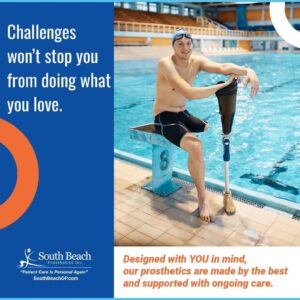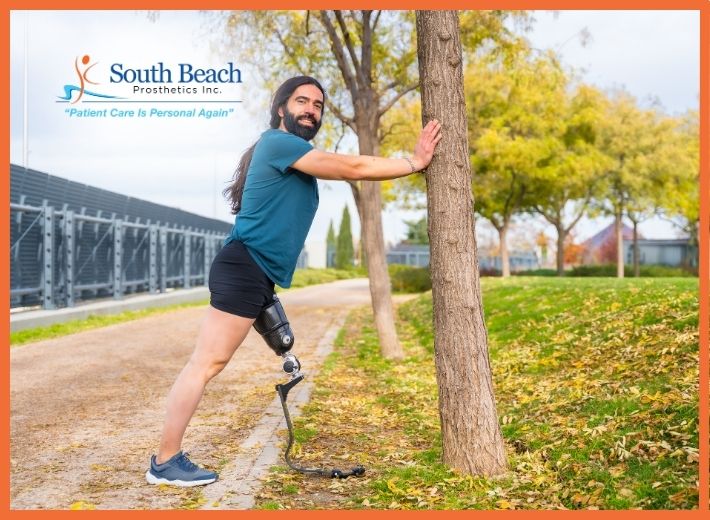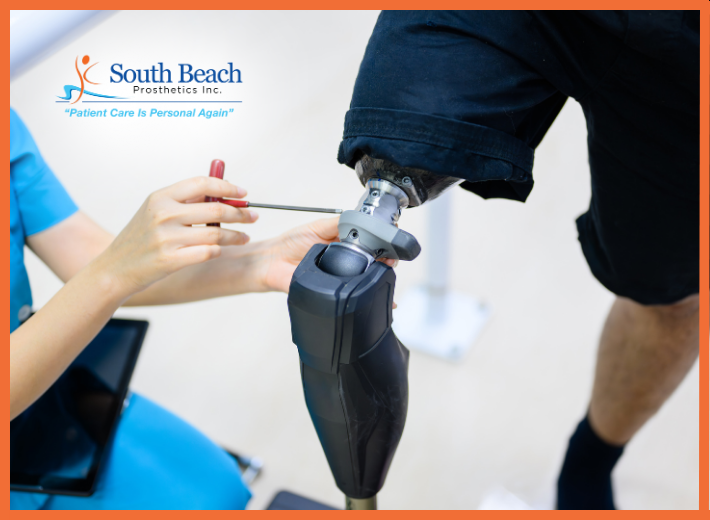Limb loss doesn’t challenge us to fix what’s broken. It offers us the chance to create ourselves—and our futures—anew. Learn more useful tips from a leadership coach and amputee.
THE PROBLEM WITH SOLVING PROBLEMS
Among the high-impact leaders I spend my days with, there is one singular epiphany that births the most spectacular businesses, innovations, outcomes, and lives. It is the awareness that in true reality, there are no such things as “problems.” There are only evolutionary invitations for us to enter the profound space where something new is created.
My clients often resist this new understanding at first, as it can come in existential conflict with their very framework of reality and even their identity. Achievement-driven leaders are conditioned to define, orient, motivate, and even create their identities around the illusion of problems. “I’m a problem-solver!”—bam, you just mandated a life of finding one problem after another, so you can keep solving them.
I offer them an entirely new way of being that’s just a thought away—one that is just as capable, even more so, of bringing forth amazing things. Here it is:
A relentlessly objective look at the universe, at nature, at reality before the human mind shrouds the fiction of meaning upon it, reveals there are actually no such things as problems. It’s never even true that “something is wrong”—not in original, naked reality.
When a limb of a redwood withers because another tree has grown near and puts it in shadow, the redwood does not stop everything it’s doing and scream: “Problem! Something wrong!” It does not try to undo or fix the situation. Instead, the redwood simply creates new limbs up higher, closer to the light, and continues to thrive. And as a bonus, the new limbs create a bridge for a hungry family of squirrels to access the redwood’s cones and carry the seeds of the next generation of redwoods all around the forest.
A client of mine put this theory into practice when the pandemic virtually stopped his healthy-meal startup. Instead of seeing this as a problem that needed to be solved, my client looked for paths toward new creation and evolution. He pivoted from a business-to-consumer model (withering limb) to a business-to-government model (new limb), because government agencies suddenly had great demand to feed people whose lives had been disrupted. The company made six times the revenue, and ten times the mission, from the previous normal year.
This metaphor is easy for my clients to understand, but it can be hard for them to integrate it fully into their mindset and alter behaviors accordingly.
I understood why when, in 2022, I opted to amputate my left leg, which had been withering for years from the long-term impact of cancer. I had spent a lot of time and effort working with supremely talented doctors to solve the problem of that leg. But the outcome of all that mental and emotional investment was that I was sequestered in a hospital bed for months with a limb that no longer functioned. Letting go of it wasn’t easy until I chose to follow the advice I’d been giving for years. Only when I chose to let go of that leg, and let go of my determination to solve that problem, could I fully reengage with my life.
Within a week of my amputation, I was back doing my life’s calling, and actually doing it much better and more clearly than I had in years.
When you look out and interrogate the true, natural world, you see that there are no problems in the universe—just moments in which evolution asks for new creation. In fact, the only thing ever taking place in the universe is creation in service to evolution.
We make up everything else.
The Beauty of Perpetual Innovation
Problems are a very recent, illusory construct of the human mind. The mind becomes attached to an outcome, a preference for the way things should be. When reality goes a different way, one that does not exactly match our preference, our mind projects the made-up construct of problem onto that occurrence. The problem then feels like a real thing to us. As a result of buying into all of this, we end up having a negative experience. And because the universe so often goes a different way from our preference for how things should be with respect to jobs, money, relationships, health, family, etc., we delude ourselves into seeing problems everywhere. And that prevents us from seeing the potential for even greater things to emerge. Instead of pursuing creation in service to evolution, we have an enduring and recurring negative experience of life.
Only if the problem is “fixed” (yep, another made-up construct) can we allow ourselves to resume having a good experience—which lasts exactly one second before the universe diverges from our preference in some other way. Problem, fix, repeat. Problem, fix, repeat.
It’s incredibly easy to fall into this pattern after losing a limb. We should have four limbs, enabling us to do certain things in certain ways. Therefore, fixing the problem of limb loss means trying to reconstitute the life we should have—or did have. But what if we step back into reality, pierce the veil of thought that made us perceive a problem, and stop looking for a fix? What if we ask, instead: “If the universe is asking for something new to be created, through me, in service of evolution…what might that be?”

A recent article in the Harvard Business Review examined companies that achieve “perpetual innovation”—that continue innovating after an initial success. One of the surprising examples the author cited was Microsoft, which under new CEO Satya Nadella has changed the company’s posture from “defense to offense.” That’s another way of saying the company pivoted from a fix-the-problem orientation (defend the status quo) to a creation orientation (pursue a new status quo to score new successes).
“This reorientation was accompanied by a strategic shift,” the article noted. “Instead of protecting its assets in a defensive [problem-solving] posture, Microsoft went on offense [creation], ceding big investments in existing tech and looking to jump into emerging opportunities.”
I love the phrase “perpetual innovation.” In nature, where there is no misperception of problems, perpetual innovation is the prime directive. In fact, the natural universe is so maniacal about innovation that it hasn’t repeated itself once in 14 billion years. That’s perpetual innovation. Not even the same snowflake twice—ever. Everything you see is an absolutely new thing. You—yes, you—your form and persona have never existed before and will never exist again, ever. You are simultaneously ordinary and infinitely unique and precious.
You, yourself, are the outcome of, and evidence of, nature’s perpetual innovation. Your existence is the culmination not of nature’s constant problem-solving but of its undaunted, constant creation of the new. You and everything in your life directly refute your mind’s made-up lament that there are problems everywhere.
Anything’s possible when we wipe our perceptual lens free of the fictional smudge of problem and look at every moment as our universe does: “What new is to be created here?” Bucky Fuller said it irrefutably: “You never change things by fighting the existing reality. To change something, build a new model that makes the existing model obsolete.”
Amputees Thrive on New Creation
In my practice as a leadership coach, I have seen “build a new model” in glorious effect again and again among organizational leaders. And as a new amputee, I’m also seeing it manifesting everywhere I look within the limb-loss community.
One example is Cassandra Quave, who required a right below-knee amputation due to congenital factors, then needed follow-up treatment for complications from an antibiotic-resistant infection. This experience gave rise to Quave’s lifelong investigation of plant-based medicinal approaches in cultures around the world. Instead of trying to “fix the problem” of drug-resistant bacteria, Quave saw an opportunity to create an alternative class of medical tools. Her approach may give humanity a new model for battling infection, making the old antibiotics-based model obsolete.
Albert Yu-Min Lin was creating new branches of evolution long before losing his leg in 2016. Renowned as a scientist, innovator, technologist, entrepreneur, and National Geographic Explorer, Lin developed a platform to resolve geographic mysteries by crowd-sourcing vast amounts of satellite imagery. The Engineers for Exploration program he launched at the University of California, San Diego (UCSD), sent hundreds of students into field expeditions around the globe. When an accident forced the amputation of his right leg, Lin alchemized that problem into new creation with UCSD’s Center for Human Frontiers. This interdisciplinary, project-driven research institute promotes an array of revolutionary technologies, including one that can improve access to prosthetic limbs among the world’s 40 million amputees. Fittingly enough, Lin’s middle name, Yu-Min, translates to “citizen of the universe.”
A third amputee who broke free of the problem-solving trap is Erica Cole. She lost her left leg in a car accident while completing a university degree in chemistry, and her new disability left her unable to accept the prestigious job she had been offered as a scientist at Los Alamos National Laboratory. But, inspired by the difficulty in finding jeans to accommodate her prosthesis, Cole made a rapid and profound pivot to become an adaptive clothing entrepreneur. Her startup, No Limbits, is rapidly rising within the industry, fueled in large part by Cole’s successful partnerships with Mark Cuban and Emma Grede on Shark Tank. Instead of dwelling on the losses of her limb and career as problems, Cole instantly recognized the opportunity for new creation, building a thriving business that brings her joy and fills a glaring need for functional, fashionable adaptive clothes.
All three of these individuals acted exactly like the redwoods: When they lost a limb, they chose to create new ones up higher, closer to the light. They chose to not orient around problem-solving, focusing instead on “What is to be created through me now?” All answered the call mightily.
We Can Only Go Forward
I can hear the clamor building, so I will articulate it myself: “I call bullshit, Souder. Limb loss brings real problems. Loss of mobility. Pain management. High healthcare costs. Loss of income. Ruptured relationships…Souder, mental health—are you telling me limb loss doesn’t cause problems?! I call bullshit.”
I hear you.
The pain of reality can be so powerful that it moves us into a conditioned consciousness that’s built around problems. But as someone who received a terminal cancer prognosis as a teen, and who now has a very high above-knee amputation of the left leg, I don’t share any of this from a place of utter naiveté nor situational ignorance. I share it from experience. And what I’ve discovered is that when I have approached any of my circumstances as problems, I have not been successful in seeing a way forward. When I approach them as an opportunity to create and evolve into something new—when I ask, “What is to be created?”—it opens up exponentially greater possibilities for how I can make my life better. It’s simply a more practical route to positive outcomes.
At age 18, I was diagnosed with metastatic sarcoma and told I had 18 to 36 months to live. The all-powerful forcing function of mortality moved me fairly quickly out of problem-solving mode to the ultimate practicality of “What is to be created?” I could stay in problem-solving mode and orient what remained of my life around a desperate attempt to fix my cancer, or I could focus on creating the most full and wondrous life possible for whatever time I had left. Shifting into “What is to be created?” mode opened me up to the kind of possibilities a human life is meant to experience.
When I outlived my diagnosis by many decades, I already had made the conversion from problem-solving mode to creation mode. It became the operating system for all my further choices in life. The by-product has been the privilege of helping others make that shift.
The forcing function that directed me toward creation mode was a terminal prognosis. But a “terminal prognosis” is, in itself, an example of the faulty problem-solving mode. The truth is, we are all living with a terminal prognosis. Not figuratively. Literally. That’s another absolute truth in nature. Everything and everyone is evolution happening, simultaneously dying and birthing the new through what we choose to create. In choosing, moment by moment, between problem mode and creation mode, we build an experience called our life. So ask yourself: “Is my health and well-being best served by choosing to orient my life around solving problems? Or do I want to be a catalyst of evolution, with a wide-open aperture of possibility, and discover what is to be created through me?”
When we frame a situation as a problem that needs to be fixed, we create a stress scenario, which alters brain functionality to the detriment of creativity. An MRI study by Harvard and Yale psychologists showed that creativity is at its maximum when the brain is in “diffuse mode” and all three brain networks (salient, default, and executive) are freely collaborating. By contrast, stress-induced “focused mode” destroys the very neuroanatomy that generates creativity. “The hippocampus also allows us to imagine the future,” says New York University neuroscientist Wendy Suzuki. “Long-term stress is literally killing the cells in your hippocampus…zapping your creativity.”
Imagine if leaders in business and government replaced the question “What is the problem to be solved?” with “What is evolution asking us to create?” or “What new world are we being given the opportunity to create?” How would that impact the choices they make, and the degree of imagination they apply toward bringing us into a vibrant, thriving, and healthy future?
Imagine if those leaders could learn from the experience of people who’ve lost limbs and, like the redwood, created new ones up higher, closer to the light?
When we really look at it, problem-solving’s North Star of success is to somehow get us back to the relative familiarity of what was, whereas asking “What is evolution calling us to create?” is an aspiration to move ahead to the next, better place. When we’ve lost a limb, there is no going back; we can only go forward. It becomes a true imperative to redirect our gaze from “what was” toward “what can be.”
In service to your future, your right-now, your very life, isn’t it worth it to at least run the experiment? Take whatever you’re currently seeing as a problem—the biggest one—and simply ask: “What might evolution, and my limitless self, be asking me to create here instead?”
If approached with conviction, that one simple question could become the trimtab that turns every moment toward your greatest life.
Experience the beauty of movement again. South Beach Prosthetics is here to help you every step of the way, from designing the prosthesis to getting you to the perfect fit. Contact us today at 888-819-4721. Follow us on Instagram for more tips.
Reference: [ https://livingwithamplitude.com/article/the-problem-with-solving-problems/ ]




